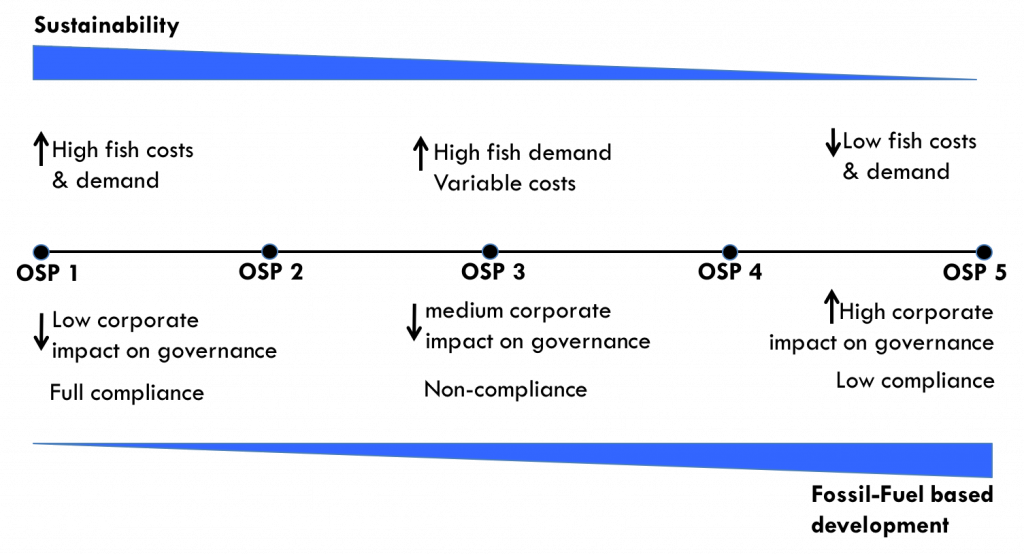Original article
Maury, O., Campling, L., Arrizabalaga, H., Aumont, O., Bopp, L., Merino, G., Squires, D., Cheung, W., Goujon, M., Guivarch, C., et al. (2017). From shared socio-economic pathways (SSPs) to oceanic system pathways (OSPs): Building policy-relevant scenarios for global oceanic ecosystems and fisheries. Global Environmental Change 45, 203–216.
“Sustainable development is the pathway to the future we want for all. It offers a framework to generate economic growth, achieve social justice, exercise environmental stewardship and strengthen governance.”
-Ban Ki-Moon (G20 dinner, 2013)
On September 2015, the UN General Assembly passed a resolution. This resolution urges nations to adopt a set of goals aimed at protecting the planet, eradicating poverty, and ensuring prosperity for all. Termed as the Sustainable Development Goals, the agenda consists of 17 objectives, with 169 targets proposed to be achieved by 2030. Goal 14 beckons the world to conserve and sustainably use the oceans, seas and marine resources. With 70% of the Earth’s surface covered by the world’s oceans, and oceanic ecosystems having major influence on atmospheric CO2, climate, food supplies, and livelihood, this is an important goal. But the million (or billion) dollar question is: how do you create a framework for change?
In 2013, scientists from a myriad of fields, along with members of the European fishing industry, and other international organizations, walked into a workshop organized by UNESCO, and came up with a plan.
Their aim: to use an interdisciplinary approach and develop model-based scenarios to ensure sustainability of marine systems.
In order to generate these models, the group used the Story and Simulation (SAS) methodology, an approach that combines qualitative and quantitative information to develop scientifically sound scenarios. In this approach, experts define the scenarios, which is subsequently translated into quantitative parameters that feed into simulation models (Fig 1).

For this particular study, the researchers focused on oceanic fisheries, which target large pelagic fish species living in open waters such as tuna, and play a critical role from various standpoints. For example, from an economic view, these fisheries not only act as a vital source of protein and nutrients, with approximately 90 million tonnes of fish caught every year, but also provide livelihood to millions, having a market value of more than 130 billion USD. Ocean fisheries also have a social importance because they act as unifying elements of various cultures. Additionally, since most of the human population live near coasts, how fisheries are managed and run affects the ocean environment.
So what is the issue?
Anticipated changes due to global warming suggests that there would be a global redistribution of fish types and yield, with expected increase in fisheries catch in high-latitudes regions and substantial decrease in the tropics. Oceanic fisheries need to be prepared for these changes.
Why would generating scenarios be helpful?
Creating possible socioeconomic future scenarios would deepen our understanding of
- how climate change affects social-ecological aspects of oceanic fisheries
- the services provided by oceanic fisheries to societies
- effectiveness of alternative strategies to sustainably manage these fisheries
What scenarios did they generate?
The researchers recognized that there are three main domains that influence how the social-ecological aspects of oceanic fisheries function:
- Economic: the driving forces that structure the economics of oceanic fisheries are the demand for fish, and the cost of harvesting, processing and transporting these resources.
- Governance: this includes relationships between states and countries, along with the global reach of multinational corporations.
- Management: the key components include the importance of sustainability, and the degree to which different actors of the oceanic system comply to the management.
Using these three frameworks, they came up with five qualitative scenarios (or possible future worlds) called oceanic system pathways (OSPs). Each of these offered plausible and consistent storylines, which were generated based on assumptions ranging from sustainable-minded society, to a fossil-fueled based world (Fig 2). Qualitative assessments under a sustainability-based world scenario (OSP1) indicate that prices and demand for fish would be high, interference from corporations would be low, and compliance with management would be high. On the other spectrum, under a fossil-fuel based mentality (OSP5), fish demand and costs would be low, interference from corporations would be high, with a focus on profit-maximization. The researchers also evaluated that in this situation, cooperation and consideration with management would be low.

Some words of caution: these scenarios, while plausible, are still caricatures of potential futures and their effect on how oceanic fisheries might be managed. Being qualitative models, they have limited use when it comes to generating policies and creating action. The researchers ultimately aim to work off these scenarios and create long-term objectives and effective strategies to transition oceanic fisheries towards a sustainable future. For a world that is already grappling with the varied challenges of global warming, considering all possible futures is going to be a crucial step for being prepared for them.
I’m a fourth year PhD candidate in the Department of Psychology at Northeastern University. My research focuses on the impact of early life stress in the form of maternal separation on neurological and behavioral abnormalities that appear later in life. Being a biologist at heart, marine sciences have always fascinated me. Check out my twitter @prabarna for more science-related fun!


